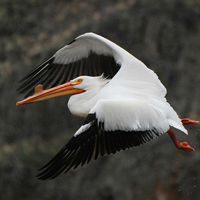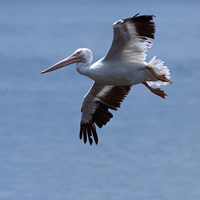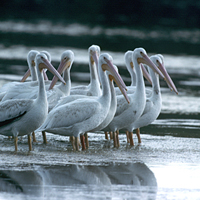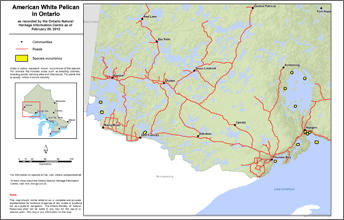American white pelican
Scientific name: Pelecanus erythrorhynchos




Cover photos credit: J.D. Taylor (left and middle-left), Scott Butner (middle-right and right)
Status
Threatened
Threatened
means the species lives in the wild in Ontario, is not endangered, but is likely to become endangered if steps are not taken to address factors threatening it.
Date added to the Species at Risk in Ontario List
The American White Pelican was assessed as endangered when the Endangered Species Act took effect in 2008 and was re-assessed as threatened on February 18, 2009.
What it looks like
The American White Pelican is a very large bird weighing about 6-7 kg, with white feathers and black wing tips.
It has a large orange-yellow bill and pouch, a short, stout tail, webbed feet and a wingspan of up to three metres.
Juvenile birds have greyish feathers during their first summer and autumn. This bird usually does not stray far from the water.
Where it lives
American White Pelicans nest in groups on remote islands that are barren or sparsely treed located in lakes, reservoirs, or on large rivers.
Remote islands offer eggs and chicks some protection from predators.
Pelicans nest in slight depressions in the ground with sticks and vegetation piled up around them. Their diet is mainly fish.
Where it’s been found in Ontario
American White Pelicans are found across the north-central and western United States. In Canada, they are found from the interior of British Columbia, east to northwestern Ontario.
These birds migrate south to the Gulf Coast states and Mexico. Ontario has about 10 per cent of the world’s population of American White Pelicans.
View a Larger version of this map (PDF)
What threatens it
Changes in water levels can have a major impact on breeding American White Pelicans.
High water levels can flood nests whereas low water levels can make nesting colonies susceptible to more predators, such as coyotes, through land-bridges.
Disease (e.g., avian botulism and West Nile) and human disturbance are also threats.
American White Pelicans are also susceptible to shooting, oil spills and water contamination on their southern wintering grounds.
Action we are taking
Threatened species and their general habitat are automatically protected.
Recovery strategy
A recovery strategy advises the ministry on ways to ensure healthy numbers of the species return to Ontario.
Read the executive summary (February 18, 2011)
Read the recovery strategy (February 18, 2011)
Government response statement
A government response statement outlines the actions the government intends to take or support to help recover the species.
Read the government response statement (November 18, 2011)
Five-Year Review of Progress
A five-year review reports on progress made toward protecting and recovering a species, within five years of publishing a species’ government response statement.
Read the report on progress towards the protection and recovery of 27 species at risk, including American White Pelican (2016)
Habitat protection
A habitat regulation defines a species’ habitat and may describe features (e.g, a creek, cliff, or beach), geographic boundaries or other unique characteristics.
Read the habitat summary (July 1, 2012)
Read the regulation (July 1, 2012)
What you can do
Report a sighting
- Report a sighting of an endangered animal or plant to the Natural Heritage Information Centre. Photographs with specific locations or mapping coordinates are always helpful.
Volunteer
- Volunteer with your local nature club or provincial park to participate in surveys or stewardship work focused on species at risk.
Be a good steward
- Private landowners have a very important role to play in species recovery. If you find American white pelican nesting on your land, you may be eligible for stewardship programs that support the protection and recovery of species at risk and their habitats.
- Bird Studies Canada is working to advance the understanding, appreciation and conservation of wild birds and their habitat in Ontario and elsewhere. For more information on how you can help, visit: Birds Canada.
Report illegal activity
- Report any illegal activity related to plants and wildlife to
1-877-TIP-SMNR (847-7667) .
Quick facts
- Unlike other pelicans that drop from high in the sky to catch fish, the American White Pelican simply floats along the water and scoops up fish with its enormous bill.
- American White Pelicans can cooperate in small groups to “herd” fish into shallow areas where they can be easily caught.
- American White Pelicans are a spectacular sight in flight. They almost always travel in groups and fly gracefully in line or “V” formation, flapping slowly in unison. Though they do not look like they are in a hurry, these birds can reach speeds of 50 kilometres per hour.
- American White Pelicans are agile fliers. They can soar very high in the sky (so far that they disappear from sight) and then plummet back to the water.
